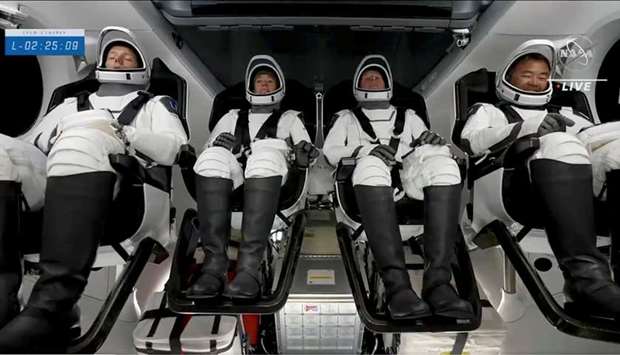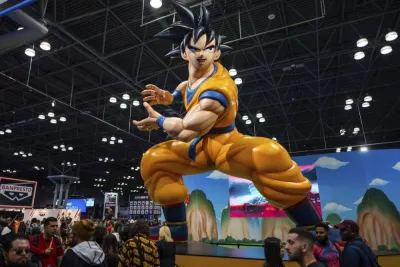The SpaceX Crew Dragon Endeavour docked with the International Space Station (ISS) early Saturday, a livestream showed.
Soft capture -- the first phase of docking -- occurred at 5:08 am Eastern time (0908 GMT), 264 miles (424 kilometers) over the south Indian Ocean.
Hard capture, the second stage, occurred about 10 minutes later, when 12 hooks were securely attached between Endeavour and the ISS's forward port.
‘Hard capture complete, welcome Crew-2,’ said US astronaut Shannon Walker, current commander of the ISS.
‘Thanks Shannon, we're glad to be here, we'll see you all in a few minutes,’ replied Endeavour's commander, US astronaut Shane Kimbrough.
The vestibule between the capsule is now being pressurized so that the hatches of both Endeavour and the space station can be opened.
The hatches should be opened around 7:15 am (1115 GMT), with a welcoming ceremony to follow at 7:45 am.
The Crew-2 mission, which includes the first European, Thomas Pesquet of France, blasted off from pad 39A at the Kennedy Space Center in Florida before dawn on Friday.
Endeavour is carrying the third crew sent to the ISS by SpaceX, as part of the company's multibillion dollar contract with NASA.
It's also Endeavour's second trip to the ISS.
It first flew there on the Demo-2 mission in May 2020, which ended almost a decade of US reliance on Russia for rides to the ISS following the end of the Space Shuttle program.
**************
Astronauts aboard SpaceX capsule prepare for docking at ISS
A recycled SpaceX Crew Dragon capsule with four astronauts aboard was speeding on its way to the International Space Station, where the spacecraft is set to dock early Saturday.
It was the third crew sent to the ISS by SpaceX, as part of its multibillion dollar contract with NASA, and the first time the company was reusing a rocket and spacecraft.
The Crew-2 mission, which includes the first European, Thomas Pesquet of France, blasted off from pad 39A at the Kennedy Space Center in Florida before dawn on Friday.
‘We're glad to be back in space,’ said mission commander Shane Kimbrough of the United States.
The Crew Dragon capsule, named Endeavour, is expected to dock with the ISS at 5:10 am (0910 GMT) Saturday. The hatch will open two hours after that.
Flying on used vehicles is a key cost-saving goal of NASA's partnerships with private industry.
Three white Teslas that whisked the astronauts to the launchpad bore license plates reading ‘recycle,’ ‘reuse,’ and ‘reduce’ -- a nod to the fact that both the Falcon 9 booster and Endeavour were deployed on previous missions.
SpaceX's first crewed mission to the ISS launched last May, ending nine years of American reliance on Russian rockets for rides, following the end of the Space Shuttle program.
‘I think we're at the dawn of a new era of space exploration,’ said SpaceX founder Elon Musk, who made a surprise appearance at the post-launch press conference.
The arrival of the space quartet -- which also includes American Megan McArthur and Japan's Akikho Hoshide -- will bring the number of people on the station to 11, as the Crew-2 team overlaps for a few days with Crew-1 astronauts, in addition to three Russian cosmonauts.
- Major step for Europe –
The launch is a major milestone for Europe, which named the mission ‘Alpha’ after the star system Alpha Centauri.
‘This is really the golden era for us in terms of exploitation of the International Space Station,’ Frank De Winne, head of ISS programs for the European Space Agency (ESA), told AFP.
Germany's Matthias Maurer and Italy's Samantha Cristoforetti are set to follow Pesquet on SpaceX missions, this fall and next spring respectively.
The next module of the ISS, built by Russia, should reach the station in July and will include a robotic arm built by ESA that Pesquet will help make operational, added De Winne.
ESA will also be a key partner to the United States in the Artemis program to return to the Moon, providing the power and propulsion component for the Orion spacecraft, and critical elements of a planned lunar orbital station called Gateway.
- Science goals –
The Crew-2 team has around 100 experiments in the diary during their six-month mission.
These include research into what are known as ‘tissue chips’ -- small models of human organs that are made up of different types of cells and used to study things like aging in the immune system, kidney function and muscle loss.
In terms of the environment, by the time Crew-2 returns in fall, it will have taken 1.5 million images of the Earth, documenting phenomena like artificial lighting at night, algal blooms, and the breakup of Antarctic ice shelves.
Another important element of the mission is upgrading the station's solar power system by installing new compact panels that roll open like a huge yoga mat.



